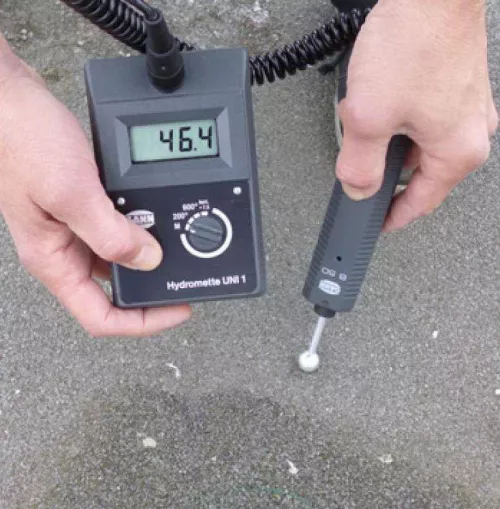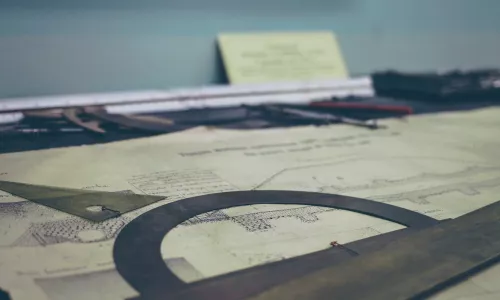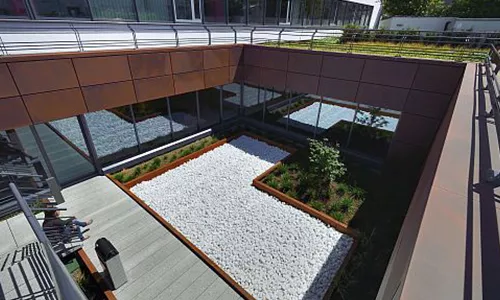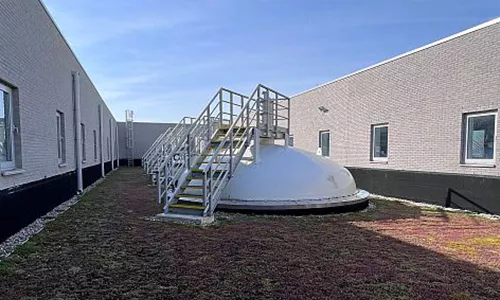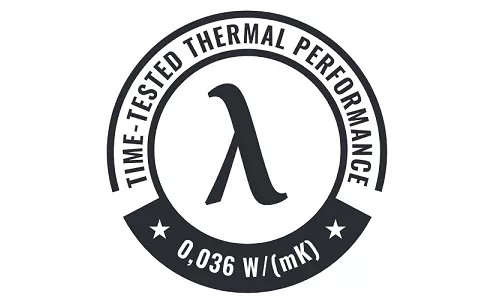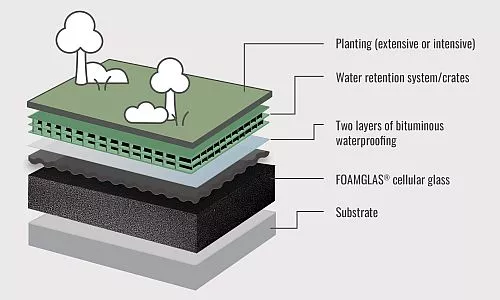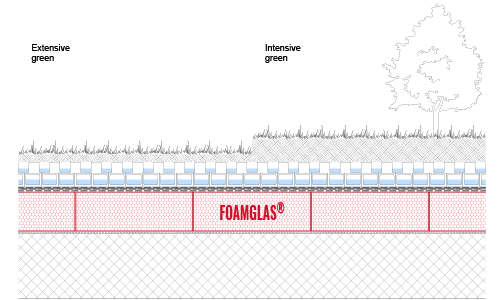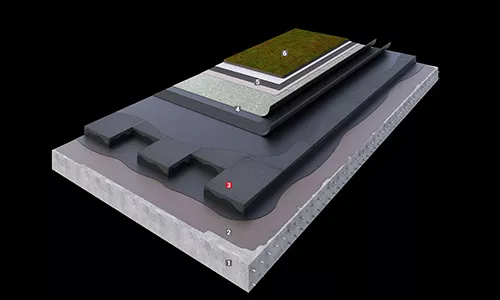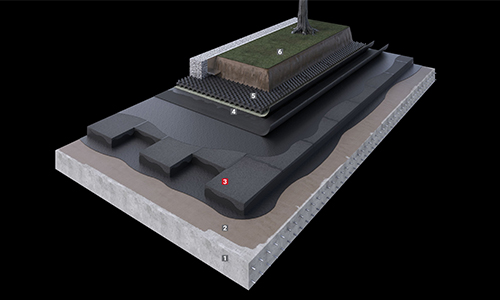Planning and implementation principles for active roofs
Optimal insulation of green roofs
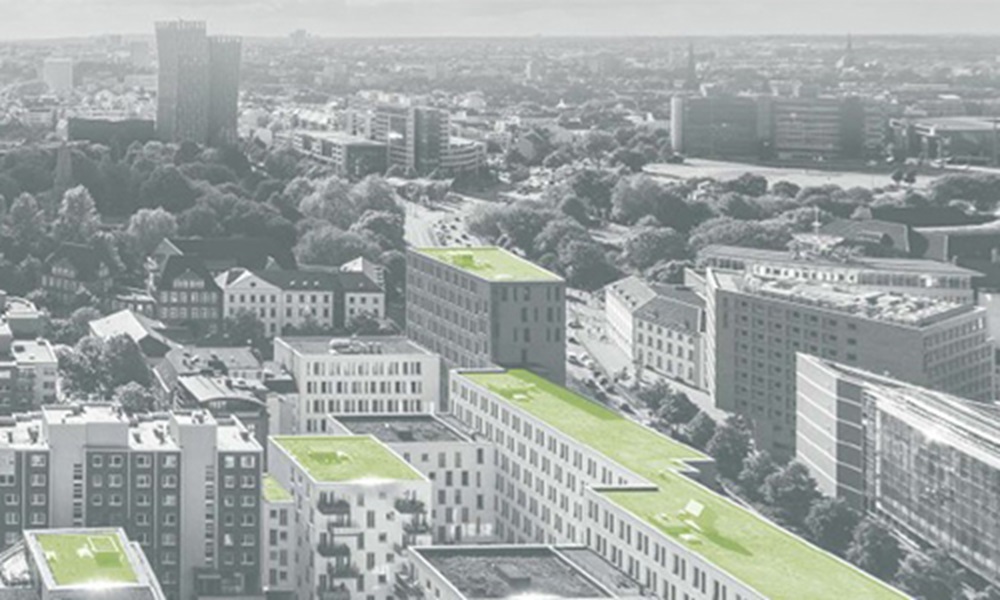
The roof is an essential part of a building's protective exterior, also known as "the Fifth Facade." It is crucial for building owners to ensure that their active roof is waterproof and safe, as it should remain functional for decades.
A properly constructed roof can meet aesthetic, economic, and environmental design requirements, but it is important to take into account usage and building physics requirements to achieve a long roof lifespan.
If water and/or moisture enters the roof structure through leaks or condensation, it will lead to various damage scenarios, such as water damage in the building, possibly resulting in mold growth.
A less noticeable form of damage occurs when water and/or moisture is present in a roof structure, causing a significant energy loss. Water or moisture is a good conductor, and once insulation is damp, it loses much of its energy-saving function. This additional energy loss also incurs extra costs. Often, this issue remains unidentified until a thorough roof inspection, while the energy loss has been occurring for quite some time.
With active roofs, including green roofs, it is important to provide a correct roof structure from the beginning of the design phase for the following reasons:
- The correct roof structure that can support the type of active roof
- The right insulation according to the loads and requirements of the green roof
- The correct waterproofing in relation to root growth and other requirements
- The proper green build-up with the right substrate
- The appropriate choice of slope and drains
Once the construction is determined correctly, the implementation follows, which must be properly executed by experienced professionals at the right price. The slogan "Cheap is expensive" certainly applies here, as experience has taught us.
With green roofs, especially intensive green roofs, it is not easy to remove the roof package over time if the roof structure has suffered damage. The costs are then much higher than when starting with a good build-up and proper implementation. Therefore, proper preparation is absolutely required to achieve a sustainable green roof.
ADDED VALUE OF GREEN ROOFS
Due to many societal problems, such as:
-
Global warming and its effects in cities
-
Flooding issues
-
Urban planning constraints
-
Lack of biodiversity
-
Energy transition
-
...
Green roofs, in any form, offer a part of the solution.
- Green roofs help reduce heat islands in urban areas, improve air quality, buffer rainwater, and add aesthetic value.
- Green roofs capture fine dust from the air and retain it.
- Green roofs increase urban biodiversity and contribute to a healthy and pleasant living environment, reducing stress and improving satisfaction and health.
- Green roofs maintain cooler temperatures during summer compared to ordinary roofs.
- This also keeps the building cooler for longer, reducing the need for cooling.
- Green roofs absorb noise, creating a quieter environment.
BUILDING PHYSICS ASPECTS OF GREEN ROOFS
Roof Build-up
When considering green roofs, it is important to take into account building physics aspects, such as the roof type. Two recommended roof types are mentioned: the warm roof and, alternatively, the inverted roof, provided that certain preconditions are met.
One of the fundamental principles for green roofs is to prioritize a fully adhered package for both insulation and roof waterproofing. The use of FOAMGLAS® Compact Roof provides an exceptionally high-quality solution for green roofs because all layers are fully adhered, creating a completely watertight and secure roof structure.
THERMAL PROPERTIES
In terms of thermal properties, green roofs contribute very little to the insulation effect of a roof. This contribution is negligible with extensive green roofs due to their low build-up thickness and the moisture present in the vegetation build-up. However, with intensive green roofs, it can be beneficial to include the different layers in the calculation due to their greater build-up height.
In general, the insulation contribution of green roofs is minimal, as their insulating capacity is most effective in winter when the roof build-up is damp. Consequently, there will be virtually no additional insulating effect achieved. Therefore, it is best to calculate the thermal performance of green roofs without considering the green roof structure. However, it is true that a green roof structure does have a cooling effect on the environment due to moisture evaporation. Another advantageous effect of green roofs is that they provide a better phase shift, resulting in slower heating of the space underneath the roof.
SOUND INSULATION
In terms of sound insulation, green roofs contribute to reducing noise both inside the building and in its surroundings. For intensive green roofs, this reduction can reach up to 50 dB(A) (garden roof), while for extensive green roofs, it is naturally lower, ranging from 6 to 8 dB(A). It is still important to be mindful of potential noise leakage from skylights, drains, and other elements.
WATERPROOFING
Full adhesion is preferred for waterproofing. This has the advantage that in the event of a leak, the risk of water spreading within the roof structure is significantly reduced. FOAMGLAS® Compact Roof, which involves fully adhering FOAMGLAS® insulation with hot bitumen or cold adhesive, provides the best guarantee for high-quality green roofs.
Adequate curb height must be incorporated into the design, as the roof build-up of green roofs can sometimes reach up to 1 meter. Consequently, waterproofing should be applied at least 15 cm above the roof build-up of the green roof. It is recommended to apply the waterproofing in fully bonded two layered waterproofing. The waterproofing material can be bitumen or synthetic such as EPDM or other suitable synthetic membranes, for full adhesion. It is important to use membranes that possess the necessary certifications for use in green roofs.
Green roofs are classified into two groups, namely extensive green roofs and intensive green roofs.
Characteristics of extensive green roofs:
-
Build-up height of up to approximately 15 cm
-
Weight per m² ranging from 30 kg/m² to 150 kg/m² (including deadweight)
Characteristics of intensive green roofs:
-
Build-up height ranging from 15 cm to 1 m
-
Weight per m² ranging from 220 kg/m² to 1000 kg/m² (including own weight)
DRAINAGE, FILTER, AND SUBSTRATE LAYERS FOR GREEN ROOFS
The following aspects apply to the drainage, filter, and substrate layers for green roofs:
-
Drainage layer: This layer facilitates water drainage and is primarily combined with a filter and protection function in extensive green roofs. Ensure a sufficient slope to allow smooth rainwater drainage. To ensure proper drainage, the simplest method is to integrate the slope directly into the insulation rather than in the substrate. Our team of experts calculates the ideal slope for the roof surface, taking into account all project specifications and national regulations. The slope is integrated into the FOAMGLAS® TAPERED insulation layer, eliminating the need to include the slope in the substrate and making the system lighter. No slope concrete is required.
-
Filter layer: The filter layer ensures the capture of small particles and prevents long-term clogging of the drainage layer. The filter layer should consist of a waterproof material that does not release substances harmful to the plants.
-
Substrate layer: The substrate layer is the most essential component of the green roof. Together with the plants, this layer forms the living material of the green roof. The substrate can be of various types, such as mixed soil, more natural mixtures, mineral granules, or substrate slabs. Vegetation mats are only used in extensive green roofs as they contain both the substrate and the plants in one layer.
1 Concrete roof deck
2 Primer coat
3 FOAMGLAS® or FOAMGLAS® TAPERED laid in hot bitumen
4 Two layers of bituminous waterproofing membranes
5 Separating layer
6 Planting (extensive or intensive)
Sammanfattning
In summary, it is crucial to demand and provide high-quality products and installations to improve the lifespan of thermally insulated flat roofs. Combining economic efficiency and ecology is the underlying philosophy behind roof structures. With careful consideration and proper installation, green roofs can be a sustainable and efficient solution for flat roof construction.


